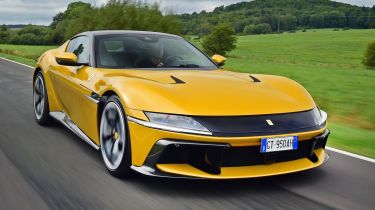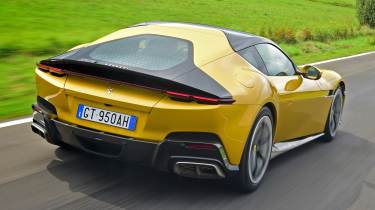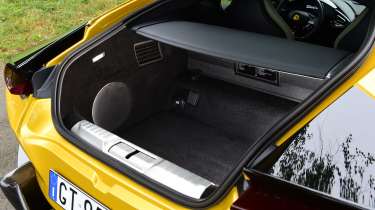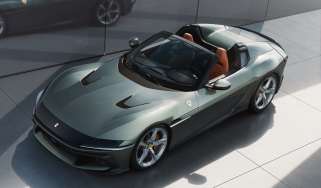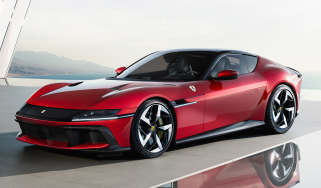Ferrari 12Cilindri review
The Ferrari 12Cilindri is an awesome new interpretation of the Daytona for the 21st century, and it drives even better than it looks

Is the Ferrari 12Cilindri a good car?
The Ferrari 12Cilindri is an amazing car, of course it is. On the one hand it is an insanely fast and engaging, if slightly old-school V12 sports car – with all the noise, drama and raw performance you’d expect. But at the same time it’s also a refined, supremely luxurious GT car; one that’s been designed to cross continents at a canter while cosseting its two occupants in unrivalled style and comfort.
As such, it covers a lot of bases and provides a unique range of abilities under just one roof. Its science fiction-meets-seventies styling might not be to all tastes, and its price will make it unattainable for most, but for the few who can afford it, there is nothing else like the 12Cilindri. If it ends up being the last of its kind – and it probably will – it will be some note to go out on for the Ferrari V12 GT car. And there have been some pretty good ones over the years.
| Key specs | |
| Fuel type | Petrol |
| Body style | 2-door coupe |
| Powertrain | 6.5-litre V12, rear wheel-drive |
| Safety |
Brake, lane & parking assist; distance cruise, alarm |
| Warranty | 4-year with 7-year free servicing |
How much does the Ferrari 12Cilindri cost?
We don’t usually talk specifics here (prices are always subject to change, after all) but for such a unique and spellbinding car, we’ll make an exception.
The Ferrari 12Cilindri costs £336,500 – or £366,500 if you’d prefer a Spider. Either way, this is one of those rare cars whose price is (almost) of no consequence to those seriously in the market for one. The VAT alone is £60k (in the UK), and if you wish to extend the four-year warranty to five years that will cost another £6,020. Basically, if you have to ask, you can’t afford it.
There is only one version of each model – with or without a roof – although there are numerous different cabin specifications to choose from. Some are deliberately more sporting (or elegant) than others, and there are near-endless trim options to pick from. Choose the ‘Daytona’ seats, for example, and it’ll cost you another £9,517. Or you can go for a pair of much more supportive carbon fibre racing seats for an extra £8,398. All the while, Ferrari’s ‘special colour’ options start at £22,500 and rise to £39,624 for a colour of your specific choice.
Engines, performance & drive
| Model | Power | 0-62mph | Top speed |
| Ferrari 12Cilindri | 819bhp | 2.9sec | 211mph |
| Ferrari 12Cilindri Spider | 819bhp | 2.9sec | 211mph |
However exciting you think the Ferrari 12Cilindri might be to drive, think again, double it and add another couple of zeros. At its core – in the nose but positioned so far back in the rear-drive chassis that Ferrari refers to the car as front-mid-engined – sits an almighty 6.5-litre V12 engine. One that produces 819bhp and can rev to a mind-splitting 9,500rpm, enough to catapult the 12Cilindri to 62mph in just 2.9 seconds.
Attached to this is a new eight-speed dual clutch gearbox that can change gear faster than you can think, up or down, and the way it combines with the instant response from the V12 is, in the end, a defining factor to the driving experience. At full chat, downshifting from sixth to third for a corner, the 12Cilindri can feel – and sound – quite a lot like a full-blown racing car.
With any of the more aggressive drive modes selected, it is so fast in its reactions to your inputs, it sometimes feels one step ahead of you. Yet because of the way Ferrari has set up the chassis (and the electronic diff) to be deliberately so playful in such modes, it’s also a car you can have a lot of fun in – so long as you know what you’re doing.
It weighs 1,560kg dry (around 1,750kg all-in) yet on the move it feels way lighter and more agile than that. You can drive it in the same way you can a BMW M3, using the throttle to guide it as much as the steering wheel. But this is also thanks to a new rear wheel-steering system, one that was originally developed for the 812, but has been perfected for the 12Cilindri. Ferrari claims it gives the car much better agility, makes it feel shorter in the wheelbase, yet provides more stability at high speed. Whatever the science behind it, the 12Cilindri’s steering is incredible. It has massive bite on turn in, seemingly zero understeer mid-corner, but feels completely relaxed bumbling along a motorway. Its breadth of ability is mighty.
As is the power and feel from the carbon ceramic brakes. We drove the car on both road and track and had no issues whatsoever in this department. They are superb.
Outright grip is also deeply impressive – and we tried the car in the wet and dry, and on both of its OE-fitment tyre (Goodyears and Michelins) options. In the wet – when you’d expect a car with 819bhp and just one driven axle to at least feel a little bit edgy – the 12Cilindri was freakishly well behaved. And in the dry, traction feels almost endless. Unless you switch the traction control off, at which point it will go sideways for days.
Select the bumpy road setting on the electronic dampers and the ride is spookily impressive. Ferrari says the car is a true GT, one that’s as sporting as it is elegant, and from the way it smooths out rough tarmac at high speeds, they’re not fibbing.
MPG, emissions & running costs
| Model | MPG | CO2 | Insurance group |
| Ferrari 12Cilindri | N/A | N/A | Group 50 |
| Ferrari 12Cilindri Spider | N/A | N/A | Group 50 |
No official fuel consumption or emissions figures are available for the 12Cilindri yet – Ferrari says these numbers are still under homologation – but given it’s powered by an atmospheric V12 that produces 819bhp at 9,500rpm, it’s safe to say the car will be very thirsty indeed. On test, we saw between 15-18mpg, and the emissions are likely to be close to 400g/km given the previous, lower-powered 812 Superfast produced 366g/km. It will therefore be very expensive to run and isn’t what you’d call good for the planet – even though Ferrari’s carbon-neutral production techniques go some way towards lowering the car’s overall environmental footprint.
Fortunately the car has a decent size fuel tank (92 litres/20.2 gallons), so although it’s thirsty it will have a touring range of between 300-350 miles.
If you have to ask how much it costs to insure a 12Cilindri, you can’t afford one; it’s in Group 50. Not that you’d get one for at least 18 months even if you wanted one, such is the demand for Ferrari’s 12-cylinder cars.
Design, interior & technology
The exterior of the 12Cilindri will not be to everyone’s taste – not straight away at least. Ferrari admits the styling is complex, challenging even, because its designers wanted to create a shape that takes time to understand and appreciate.
The front end looks like a like Daytona wearing a pair of Daft Punk shades. The profile is classic front-engined, rear-drive GT car. The rear is an unusual mix of shapes and forms that looks utterly dramatic but also multi-dimensional, even down to a pair of flaps above the haunches that open above 50mph to improve downforce. When open, these change the entire rear-end character of the car, which is a fascinating thing to see from behind.
The cabin is less complex but no less impressive or beautiful to look at or sit in. It exudes the rich smell of leather that only Ferraris ever seem to produce, and the design is all very much driver-orientated, with a 10.25-inch TFT screen in front of the driver plus an even bigger 15.6-inch screen for all other functions in the centre of the dash.
As ever, the steering wheel is festooned with buttons – too many in our opinion – and the number of sub-menus that are available via these buttons can be confusing to begin with, not least because the font size for the more detailed information on display is too small.
It’s still a lovely car to climb into and start using, but some of the on-board tech lacks intuition compared with more mainstream cars. Ferrari says this is all part of the process of getting used to your 12Cilindri. The teams say it isn’t meant to be a car you can sit in and understand everything immediately. We say it could use a shake-up in this area and be simpler to interact with, purely to make it less baffling when you first climb inside. Having said that, a nice touch is that the passenger also gets their own 8.8-inch screen so they can see how fast they’re going, which gear the car is in, how many revs the V12 is spinning at, and so on.
The options list is near endless, and contains enough variations of seating, leather qualities, trim designs and colours to enable customers to make their interior feel bespoke. You can specify your 12Cilindri to be very focused, by choosing carbon bucket seats and carbon surrounds for all the instruments and console, or you can make it more luxurious and elegant inside – with far less aggressive seats and trim to match. The exterior colour options start at £22,000, rising to £40k for “whatever colour you’d like”.
Sat-nav, stereo and infotainment
There is no sat nav in a 12Cilindri. Insetad the infotainment is fully set up to be compatible with whatever smartphone you might use, be that Apple or Android. So, in short, you use your phone’s navigation, not the car’s. Without a smartphone you’ll need a map, which is fine when there is phone signal, less great when there is not.
The rest of the infotainment system works extremely well – once you’ve spent time scrolling through the sub-menus via the steering wheel buttons to establish what’s available and how it functions. Initially it can be quite a confusing car to interact with, but after a while you learn to appreciate how much functionality there is, and how well it all works. There’s even a wireless charging pad on the centre console – a first in a Ferrari.
The quality of the Burmester sound system is almost as incredible as the noises made by the V12 engine itself. Almost, but not quite. There are 15 speakers and 1,600w of power to create what Ferrari claims is a full 360-degree listening experience. Whatever it’s called, it sounds amazing.
Boot space, comfort & practicality
| Dimensions | |
| Length | 4,733mm |
| Width | 2,176mm |
| Height | 1,292mm |
| Number of seats | 2 |
| Boot space | 270 litres |
The 12Cilindri is a genuine GT car. As such it has a decent 270-litre boot that has a much lower lip than its predecessor (the 812 Superfast) which makes it far easier to place your Louis Vuitton luggage in the back of it.
It’s also a more comfortable car than you’d expect given the performance it has. It’s got great seats, a fine long-distance ride if you select Normal or Sport modes (or Winter when it snows), with an impressive absence of road, wind or tyre noise on the move.
All round visibility is good, even if the view rearwards is partially restricted by the low window line. But the driving position is near-perfect for a GT car – with a wide range of adjustment on the fully-electric driver’s seat. Note: even the full carbon buckets are electric.
It never feels like a small car inside or on the road; it is almost 2.2 metres wide and 4.7m long. But rarely does it feel too big from behind the wheel. Physically it is not as intimidating to drive as you might imagine.
For a two-seater car that can hit 62mph in under three seconds, it’s also a fairly practical one, too. There are plenty of cubbies and stowage bins inside, and your phone can be charged wirelessly for the first time in a Ferrari. Screen reflections are non-existent (not always so in cars like this) and the cabin feels intimately spacious, but not cramped.
Safety & reliability
| Key standard safety features |
Euro NCAP safety ratings |
|
|
Ferrari takes safety as seriously as performance, it claims – hence the 12Cilindri has a full range of ADAS features. These range from lane and brake assistance, to full 360-degree mapping and warning systems to prevent the car from coming into contact with anything or anyone.
On top of this there are highly developed traction and stability-control systems, plus a complex e-diff, each designed to keep the car on the straight and narrow. For a car with 819bhp, the 12Cilindri is about as safe as it gets – so long as you keep the driver-aid systems switched on. There is still the option, however, of switching them all off.
Ferrari offers a four-year warranty as standard with seven years of free maintenance servicing. The servicing intervals are yearly or every 12,500 miles, whichever comes first – providing those in Maranello are confident about the car’s reliability. If you want a fifth year of warranty it costs an extra £6,020.
Ferrari 12Cilindri alternatives
The 12Cilindri is one of only two Ferraris offered with a V12 nowadays – the other being the quasi-SUV Purosangue. This means it essentially sits at the very top of the brand’s range, and rivals are few and far between.
The most obvious is the new Aston Martin Vanquish, which costs similar money to the Ferrari, but boasts a bit more power from its turbocharged V12 engine. It goes on sale in the Autumn with 835bhp. Elsewhere, there’s the latest Bentley Continental GT Speed, which weighs more and costs less, but is now offered only with a plug-in hybrid V8 engine.
Then comes a host of interesting but not-quite-in-the-same-league rivals such as the Porsche 911 Turbo S, McLaren GTS, Mercedes-AMG GT and BMW M8 Competition. And if you want to go seriously leftfield but remain on the same drag strip, there’s always the Tesla Model S Plaid, which has more power but somewhat less panache than the Ferrari. It’s only available in left-hand drive, and is no longer officially sold in the UK.
Frequently Asked Questions
Four years

